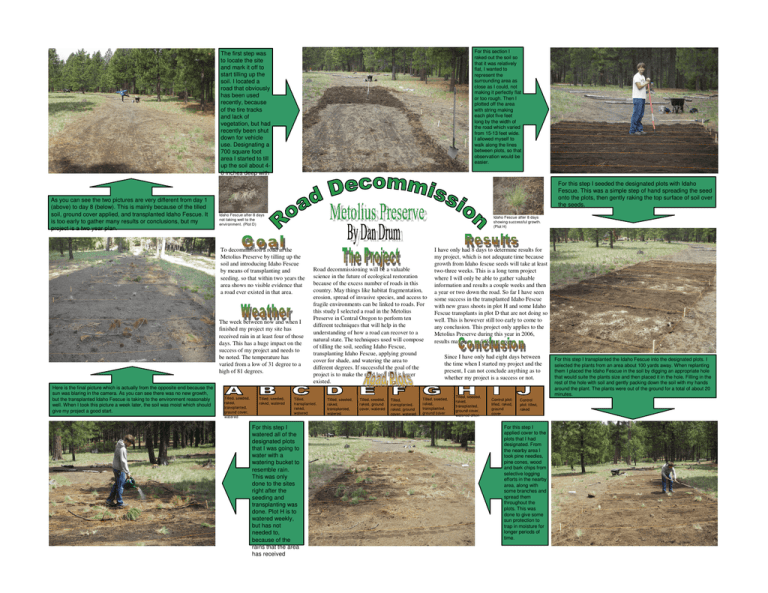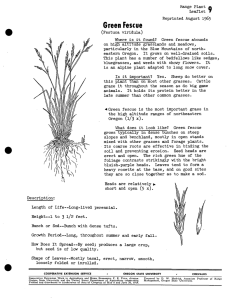I have only had 8 days to determine results for
advertisement

For this section I raked out the soil so that it was relatively flat, I wanted to represent the surrounding area as close as I could, not making it perfectly flat or too rough. Then I plotted off the area with string making each plot five feet long by the width of the road which varied from 15-13 feet wide. I allowed myself to walk along the lines between plots, so that observation would be easier. The first step was to locate the site and mark it off to start tilling up the soil. I located a road that obviously has been used recently, because of the tire tracks and lack of vegetation, but had recently been shut down for vehicle use. Designating a 700 square foot area I started to till up the soil about 46 inches deep with a shovel. As you can see the two pictures are very different from day 1 (above) to day 8 (below). This is mainly because of the tilled soil, ground cover applied, and transplanted Idaho Fescue. It is too early to gather many results or conclusions, but my project is a two year plan. For this step I seeded the designated plots with Idaho Fescue. This was a simple step of hand spreading the seed onto the plots, then gently raking the top surface of soil over the seeds. Idaho Fescue after 8 days not taking well to the environment. (Plot D) Idaho Fescue after 8 days showing successful growth. (Plot H) To decommission a road in the Metolius Preserve by tilling up the soil and introducing Idaho Fescue by means of transplanting and seeding, so that within two years the area shows no visible evidence that a road ever existed in that area. The week between now and when I finished my project my site has received rain in at least four of those days. This has a huge impact on the success of my project and needs to be noted. The temperature has varied from a low of 31 degree to a high of 81 degrees. Here is the final picture which is actually from the opposite end because the sun was blaring in the camera. As you can see there was no new growth, but the transplanted Idaho Fescue is taking to the environment reasonably well. When I took this picture a week later, the soil was moist which should give my project a good start. Tilled, seeded, raked, transplanted, ground cover, watered Tilled, seeded, raked, watered Road decommissioning will be a valuable science in the future of ecological restoration because of the excess number of roads in this country. May things like habitat fragmentation, erosion, spread of invasive species, and access to fragile environments can be linked to roads. For this study I selected a road in the Metolius Preserve in Central Oregon to perform ten different techniques that will help in the understanding of how a road can recover to a natural state. The techniques used will compose of tilling the soil, seeding Idaho Fescue, transplanting Idaho Fescue, applying ground cover for shade, and watering the area to different degrees. If successful the goal of the project is to make the road look like it never existed. Tilled, transplanted, raked, watered For this step I watered all of the designated plots that I was going to water with a watering bucket to resemble rain. This was only done to the sites right after the seeding and transplanting was done. Plot H is to watered weekly, but has not needed to, because of the rains that the area has received recently. Tilled, seeded, raked, transplanted, watered Tilled, seeded, raked, ground cover, watered Tilled, transplanted, raked, ground cover, watered I have only had 8 days to determine results for my project, which is not adequate time because growth from Idaho fescue seeds will take at least two-three weeks. This is a long term project where I will only be able to gather valuable information and results a couple weeks and then a year or two down the road. So far I have seen some success in the transplanted Idaho Fescue with new grass shoots in plot H and some Idaho Fescue transplants in plot D that are not doing so well. This is however still too early to come to any conclusion. This project only applies to the Metolius Preserve during this year in 2006, results may vary in different areas. Since I have only had eight days between the time when I started my project and the present, I can not conclude anything as to whether my project is a success or not. Tilled, seeded, raked, transplanted, ground cover Tilled, seeded, raked, transplanted, ground cover, watered often Control plot: tilled, raked, ground cover Control plot: tilled, raked For this step I applied cover to the plots that I had designated. From the nearby area I took pine needles, pine cones, wood and bark chips from selective logging efforts in the nearby area, along with some branches and spread them throughout the plots. This was done to give some sun protection to trap in moisture for longer periods of time. For this step I transplanted the Idaho Fescue into the designated plots. I selected the plants from an area about 100 yards away. When replanting them I placed the Idaho Fescue in the soil by digging an appropriate hole that would suite the plants size and then placed it in the hole. Filling in the rest of the hole with soil and gently packing down the soil with my hands around the plant. The plants were out of the ground for a total of about 20 minutes.
